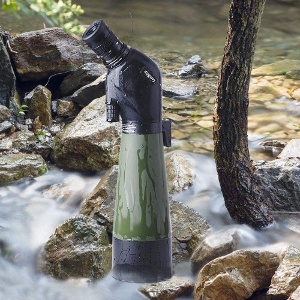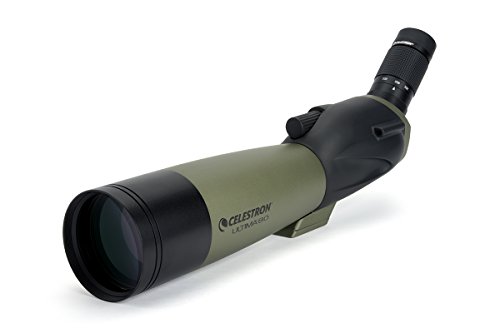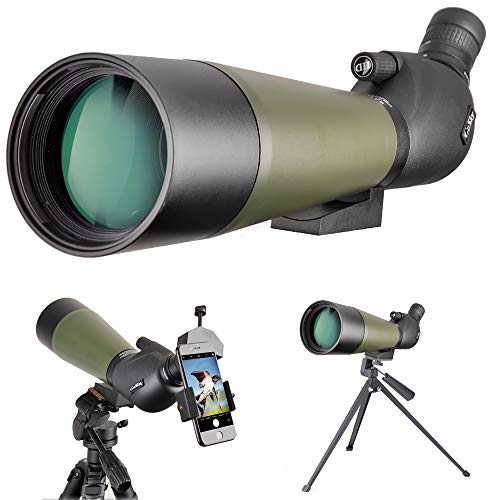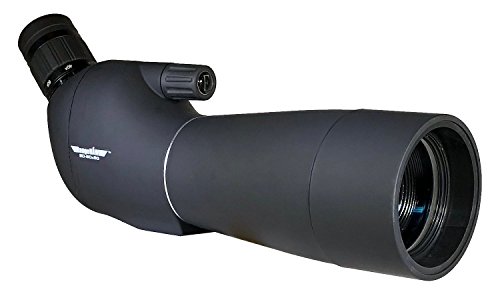5 Best Budget Spotting Scopes under $200 in 2025 – Reviews & Guide
Last Updated on

Of course, it’s not always easy to shop online. How do you know that you’re getting a good deal when every description is written by an advertiser trying to sell you their product? If you’re not sure which details are meaningful, and which are just advertising fluff, you’ve come to the right place.
We’ve assembled a list of reviews of some of the best spotting scopes for this year, and you could get each one for less than $200. We also created a buyer’s guide, designed to walk you through the ins and outs of spotting scopes, so that you can figure out which model is right for you, even if this is your first time shopping for one.

A Quick Overview of our Favorite Picks in 2025
| Image | Product | Details | ||
|---|---|---|---|---|
| Best Overall |
 |
Celestron Ultima Zoom |
|
CHECK PRICE |
 |
Bushnell Trophy Xtreme |
|
CHECK PRICE | |
| Best Value |
 |
Gosky 20-60×80 BAK 4 |
|
CHECK PRICE |
 |
RangeHAWK 20-60×60 |
|
CHECK PRICE | |
 |
BARSKA 30-90×90 |
|
CHECK PRICE |
The 5 Best Budget Spotting Scopes
1. Celestron Ultima Zoom Spotting Scope – Best Overall
The Celestron 55250 80mm Ultima Zoom is our top pick for spotting scopes under $200. It comes with an 80mm lens, which is giant for the price point, and fairly large overall while remaining safely portable. It comes with a good zoom range from 20 to 60 times magnification. The casing is also waterproof, which means that this model is safe for outdoor use and that the model will be less sensitive to humidity than other units.
The included soft case is a nice touch and gives the spotting scope one more layer of protection while you’re moving it around, which should keep it in good shape and extend its life. The downside to this model is common with cheaper spotting scopes, and that’s chromatic aberration. While it keeps color constant at its lowest level, this model has noticeable chromatic aberration at higher zoom levels, which lower the image quality and make it unsuited to photography at those levels. However, if you need something for viewing and not for photography, you’re getting a good deal with this model. All in all, this is definitely one of the best budget spotting scopes for this year.
- Giant lens
- Good zoom range
- Waterproof
- Included soft case
- Some color fringing
2. Bushnell Trophy Xtreme Spotter Scope
The Bushnell Trophy Xtreme 886015 is the runner-up on our list. It comes with a waterproof and fog-proof shell, which keeps the lens and mirrors fog-free and makes sure that you’re already getting great images, even in subpar conditions. It also includes a 12” tripod and a window mount for the same price, which saves you the hassle of trying to find compatible models on your own. It also includes a hard case, which is a nice touch at this price point, as hard cases generally give you the most confidence that your investment is protected while you move it.
However, this model only has 12 to 36x magnification. It’s adjustable, which is good, but 12x is on the low end and 36x is not that great as a topping out point. On comparable models, that would be in the low-to-medium range, so this model doesn’t have a great maximum zoom. However, if you already know that you’re not going to need a massive zoom, then this model is a great value purchase for you.
- Waterproof and fogproof
- Included tripod and window mount
- Included hard case
- Subpar magnification
3. Gosky Budget Spotting Scope – Best Value
The Gosky 20-60×80 BAK 4 spotting scope is our choice for best pick for the money. It comes with an excellent zoom range, from 20 to 60 times magnification. It’s also waterproof, which makes it well-suited to work out in the field. However, two features set this model apart from the crowd. The first is the included digiscoping adapter, which you can use to take pictures with your smartphone.
The second feature is its great price. You’re getting a very good spotting scope for about half of what you would expect, which makes for a great deal. What keeps this model from climbing higher on our list is the fact that it has poor image quality at its maximum zoom, including some chromatic aberration and general diffusion, which creates a fuzzy image. However, if you’re looking for a spotting scope that’s great in the short-medium ranges and comes with a digiscoping adapter, you’re not going to find a better one anywhere near this price point. For the money, this is the best budget spotting scope we reviewed.
- Good zoom range
- Waterproof
- Cellphone adapter included
- Price
- Poor image quality at max zoom
4. RangeHAWK 20-60×60 Spotting Scope
The RangeHAWK 20-60×60 is an example of a manufacturer adding too many extras that the base product must not be that great. They include the spotting scope, a tripod, a phone mount, and lens cover, all while having one of the lowest prices on the market. It just seems like the scope can’t that good with so many extras added at such a low price. And yet, it does a decent job. It comes with a 60mm lens and 20-60 times variable magnification that get the job done without being exceptionally clear.
However, this model has some serious downsides. The included phone mount is cheap and doesn’t work well with all models of phone. You also have to worry about questionable quality control, as this company doesn’t always include all of the add-ins when they ship. While customer support is generally good about making sure you get the extras you paid for, that’s a pain in the butt that most people won’t want to deal with. Overall, this model isn’t terrible value, but it has too many shortcomings to rise any further on our list.
- Good lens
- Good zoom range
- Cheap phone mount
- Questionable quality control
5. BARSKA 30-90×90 Spotting-Scopes
The BARSKA 30-90×90 isn’t the most expensive model on the market, but it still doesn’t do a lot to justify its price. It comes with a giant 90mm lens and a variable zoom from 30 to 90 times magnification. In theory, this could be one of the best models on our list, but it doesn’t live up to its potential. It has poor image quality past about 100 yards, which means that you’re not getting good value out of the zoom or the lens in this instance.
It’s also a very large model, which means that it can be hard to mount and that you’ll need an especially sturdy tripod when you use it. Finally, it has poor eye relief, which means that your eye needs to be very close to the lens to see the image. If you wear glasses that can be a pain in the butt. Even if you put your glasses against the eyepiece, you won’t be able to make out the image. You could spend the same amount of money on a different model and get a much less frustrating experience.
- Giant lens
- Great zoom
- Poor quality past 100 yards
- Large
- Poor eye relief

Buyer’s Guide
We hope that our reviews have given you some insight into spotting scopes and separates the great models from the not-so-great. If you want to learn more about spotting scopes or gain more insight into the criteria that we used to evaluate our picks, then you should read this buyer’s guide, which is packed full of good general information about spotting scopes.
Straight vs angled
There are two kinds of spotting scopes on the market, straight and angled. Manufacturers are sometimes misleading when it comes to the distinction between the two. Angled models are described as higher quality or as significantly more comfortable, since you can turn the eyepiece to multiple angles, and thus can find a position that you like.
That’s not strictly true. A much bigger difference between the two is that straight models are better for viewing objects that are the height as you are, while angled models do that well, but also do a good job of compensating for objects that are at a significantly-different height without a lot of chromatic aberration. While angled scopes can be more comfortable, that’s not nearly as significant relative to how they handle height differences.
Straight spotting scopes tend to be a bit longer, but have a bit less height, while angled scopes are a bit shorter in length, but a bit taller.
Zoom and lens sizes
Two numbers define every spotting scope. Typically, they’ll come in this pattern: “20×80” or “20-60×80.” The first number describes the zooms available on the spotting scope. So, if it said “20,” it would mean that it’s a fixed-zoom scope that has a magnification of 20 times.
Most modern spotting scopes are variable, or able to show you a clear image at multiple different zooms, and adjustable via a wheel on the outer casing. They represent this by saying something to the effect of “20-60” before the “x” in that phrase we mentioned earlier. A “20-60” spotting scope can vary between 20 and 60 times magnification, and in theory, provides a clear image at all zooms.
The number after the “x” tells you about the lens size. The number you’ll find there is the lens size in millimeters. So, a “20-60×80” would have a lens that is 80 millimeters in diameter. That would be big for this price point and would likely make for a good deal. You probably don’t want a spotting scope with a lens smaller than 60 millimeters.
The bigger the lens is, the more light it lets in, and the better the final picture quality will be.
Lens and mirror coatings
Lenses and mirrors don’t do a great job of reflecting and focusing light in their natural state. Early telescopes were very large to compensate for this problem. Modern spotting scopes solve this problem by with new manufacturing techniques that create complex lenses, or by applying special coatings to the glass to solve these problems.
The protective glass on untreated mirrors can absorb up to 96% of the light they’re exposed to. That’s a problem if you’re trying to create a bright final image. New chemicals, applied to the glass, can cause them to absorb less than 20% of light, which makes for a much brighter final image. Some companies use a better coating than others, so you can get better value for the same price by going with a model with a better coating.
At this price point, the best way to deal with chromatic aberration, or a problem caused by lenses focusing different wavelengths of light to different places, is to get an ED lens. ED, or extra-low diffraction lenses, use a special shape, or a chemical coating to ensure that all colors arrive at the right place, so that you will see a clear and well-defined final image.
We also reviewed spotting scopes around the $1000 mark here.

Conclusion
The Celestron 55250 80mm Ultima Zoom is our top choice, coming with a giant lens, a good zoom range, and an excellent soft case for travel. The Bushnell Trophy Xtreme 886015 is our runner-up, as it includes a great case, tripod, and window mount, and only loses the top spot due to its subpar magnification. The Gosky 20-60×80 BAK 4 is our choice for best value due to its good zoom range and included cell phone adapter. The RangeHAWK 20-60×60 is an underwhelming model that comes with serious quality control issues. The BARSKA 30-90×90 doesn’t have the best power, despite having the best lens and magnification options, making it a frustrating model to use.
Hopefully, our reviews and buyer’s guide have helped you understand what makes for a good spotting scope. Armed with this knowledge, you should be able to find the model that’s just right for you.
About the Author Robert Sparks
Robert’s obsession with all things optical started early in life, when his optician father would bring home prototypes for Robert to play with. Nowadays, Robert is dedicated to helping others find the right optics for their needs. His hobbies include astronomy, astrophysics, and model building. Originally from Newark, NJ, he resides in Santa Fe, New Mexico, where the nighttime skies are filled with glittering stars.
Related Articles:
How to Clean a Refractor Telescope: Step-by-Step Guide
How to Clean a Telescope Eyepiece: Step-by-Step Guide
How to Clean a Rifle Scope: 8 Expert Tips
Monocular vs Telescope: Differences Explained (With Pictures)
What Is a Monocular Used For? 8 Common Functions
How to Clean a Telescope Mirror: 8 Expert Tips
Brightfield vs Phase Contrast Microscopy: The Differences Explained
SkyCamHD Drone Review: Pros, Cons, FAQ, & Verdict








